
Lars Gislén
Retired, affiliated researcher

Showcasing Seventeenth-Century Jesuit Astronomy In Asia : The Lead Up To The First Scientific Observations Of A Solar Eclipse Made In Siam
Author
Summary, in English
The first great ruler to encourage the adoption of Western culture and technology throughout Siam was King Narai, who also had a passion for astronomy. He showed this by encouraging French and other Jesuit missionaries, some with astronomical interests and training, to settle in Siam from the early 1660s. One of these was Father Antoine Thomas, and he was the first European known to have carried out scientific astronomical observations from Siam, in 1681 and 1682. Later, the lunar eclipse of 11 December 1685 assumed an important place in the history of Thai astronomy when a contingent of French missionary-astronomers joined King Narai and his court astrologers and observed it from the King’s country retreat near Lop Buri. This event so impressed the King that he approved the erection of a large modern well-equipped astronomical observatory at Lop Buri. Construction of Wat San Paulo Observatory—as it was known—began in 1686 and was completed in 1687. A second contingent of French Jesuit astronomers settled in Lop Buri at about this time, and were involved in various astronomical observations. Arguably, the last of these of any importance was of the partial solar eclipse of 30 April 1688, just one week before the sudden demise of scientific astronomy in Siam. In this paper we examine King Narai’s enlightened attitude towards Western science and technology and his growing interest in Western astronomy, before discussing the observations that he and/or the Jesuit missionaryastronomers made leading up to and including the partial solar eclipse of 30 April 1688. We then explore the growing disquiet among some members of the Royal Family that triggered a coup on 5 June 1688 when King Narai was overthrown and most of the Western missionary-astronomers were expelled from Siam.
Department/s
- Theoretical Particle Physics - Has been reorganised
Publishing year
2021
Language
English
Pages
498-520
Publication/Series
Journal of Astronomical History and Heritage
Volume
24
Issue
2
Links
Document type
Journal article
Publisher
National Astronomical Research Institute of Thailand
Topic
- Astronomy, Astrophysics and Cosmology
Keywords
- 1688 solar eclipse
- astronomical observations
- French Jesuit astronomers
- King Narai
- Siam
Status
Published
ISBN/ISSN/Other
- ISSN: 1440-2807

